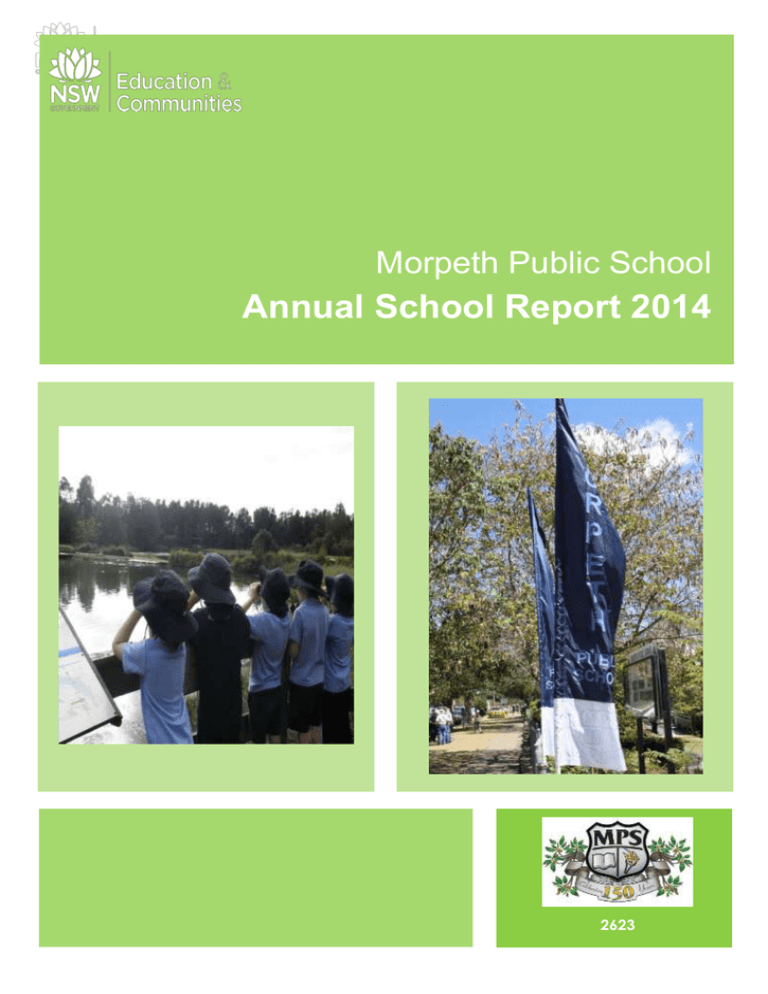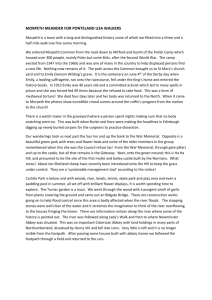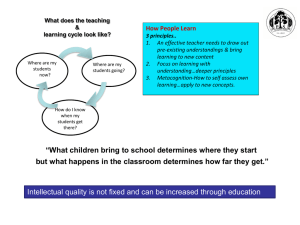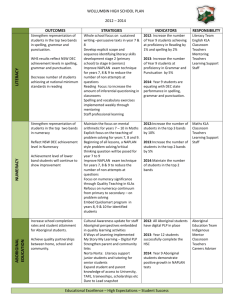Annual School Report 2014
advertisement

Morpeth Public School Annual School Report 2014 [school code] 2623 School Context Statement Morpeth Public School is situated in the picturesque and historic township of Morpeth, a suburb of the city of Maitland in the Hunter Region of New South Wales. In 2012 the school celebrated its sesqui-centenary; 150 years of continuous quality public education. Enrolments 250 Students 200 The area has a rich history that has direct links with the early settlement of Newcastle. The Morpeth area has long been associated with farming, a tradition that remains today. The township is served by the Hunter River, which was instrumental in the expansion of the original Newcastle settlement and the establishment of the Wallis Plains (Maitland) settlement. 100 50 0 2008 2009 2010 2011 2012 2013 2014 Year Male Female Student enrolment numbers have increased steadily since 2010. Enrolment data suggests that the expansion of the Raworth residential estate has been the major contributing factor to the increase in student numbers. In recent times, the establishment of the Raworth residential estate has resulted in a steady increase in school enrolment numbers. Student population in 2014 numbered 209 (P4 classification) with 13 students (6%) identifying as Aboriginal or Torres Strait Islander. The school’s Family Occupation and Education Index (FOEI) is 87, which indicates a lower than average (100) level of disadvantage. Student Attendance Profile 2014 staffing composition included, by classification, a principal, two assistant principals, seven classroom teachers, teacher of RFF (0.4), librarian (0.6), part time teacher (0.378), Learning and Support teacher (0.6) and Out of Home Care teacher (0.6). The school has a SASS allocation of one School Administration Manager (SAM) and a School Administration Officer (SAO) both employed in a full time capacity. Morpeth Public School has a dedicated and experienced staff committed to delivering engaging and innovative learning experiences underpinned by quality teaching and best practice strategies that reflect recent DEC reforms. In a time of technological and pedagogical change, Morpeth Public School is committed to ensuring all students are prepared and skilled to be effective 21st century learners. Student Information Year 2009 2010 2011 2012 2013 2014 K 92.5 93.9 95.8 96.6 95.7 96.4 1 93.0 91.7 90.6 95.7 95.4 96.4 2 91.3 94.1 95.7 96.9 94.8 96.9 3 91.9 94.9 95.6 96.1 95.1 94.9 4 93.9 93.2 94.8 96.1 96.7 96.8 5 94.2 94.1 93.8 95.8 95.0 95.8 6 94.5 94.2 94.0 96.0 94.5 94.1 Total 93.1 93.7 94.6 96.1 95.3 96.0 K 94.3 94.7 94.7 94.3 95.0 95.2 1 93.7 94.2 94.2 93.9 94.5 94.7 2 94 94.4 94.2 94.2 94.7 94.9 3 94.1 94.5 94.4 94.4 94.8 95.0 4 94 94.5 94.3 94.3 94.7 94.9 5 94 94.4 94.2 94.2 94.5 94.8 6 93.6 94.0 93.8 93.8 94.1 94.2 Total 92.1 94.4 94.3 94.2 94.7 94.8 The top figure in the graph above represents attendance data for Morpeth Public School. The bottom graph provides an overview of State DEC data. Clearly, Morpeth PS figures reflect a higher average attendance percentage than State DEC schools over a four year horizon. Students who attend Morpeth Public School primarily live in the township of Morpeth and in the adjoining Raworth Estate. Others reside in the surrounding rural areas including Phoenix Park, Duckenfield and Berry Park. As previously stated, approximately 6% of students identify as Aboriginal or Torres Strait Islander. Workforce information It is a requirement that the reporting of information for all staff must be consistent with privacy and personal information policies. Student Enrolment Profile Gender 150 2008 2009 2010 2011 2012 2013 2014 Male 85 86 82 89 100 108 108 Female 90 92 83 80 79 91 97 1 Workforce Composition Position Principal Assistant Principal(s) Classroom Teacher(s) Learning and Support Teacher(s) Teacher Librarian School Counsellor School Administrative & Support Staff Total Beginning Teachers No staff member of Morpeth Public School identified as a ‘Beginning Teacher’ in 2014. Number 1.0 2.0 7.0 0.7 0.6 0.2 2.0 13.5 Workforce Retention Due to an increase in student numbers, Morpeth Public School was able to form a ninth class at the beginning of 2014. The position was filled by Miss Simone Lambert in a temporary capacity. Long term teacher Mr Michael Hamilton, was transferred to New Lambton Public School at the beginning of the year and his position was filled by Mrs Jane Fincher. During term 3, Mrs Fincher was successful at interview through the merit selection process and she was appointed to the school as a permanent teacher. The Australian Education Regulation, 2013 requires schools to report on Aboriginal composition of their workforce. No member of the staff of Morpeth Public School identifies as being Aboriginal or Torres Strait Islander. Assistant Principal, Mrs Cheryl Carpenter, who has been employed at Morpeth Public School for 18 years, announced that she would retire at the end of the 2014 school year. On behalf of the Morpeth school community, we congratulate Mrs Carpenter on her outstanding service to our school and public education in general and we wish her well in her retirement. Teacher Qualifications All teaching staff meet the professional requirements for teaching in NSW public schools. Qualifications Degree or Diploma Postgraduate % of staff 100% 0% Financial Summary This summary covers funds for operating costs and does not involve expenditure areas such as permanent salaries, building and major maintenance. Professional Learning and Teacher Accreditation During 2014, classroom teacher Miss Jessica Stevens attained accreditation at Proficient Level through the Institute of Teachers process. Colleagues, Ms Nicole Webster and Mrs Jane Fincher are currently at Maintenance level. Date of financial summary Income Balance brought forward Global funds Tied funds School & community sources Interest Trust receipts Canteen Total income Expenditure Teaching & learning Key learning areas Excursions Extracurricular dissections Library Training & development Tied funds Casual relief teachers Administration & office School-operated canteen Utilities Maintenance Trust accounts Capital programs Total expenditure Balance carried forward Morpeth Public School is committed to improving teacher quality through targeted professional learning for all staff. The school’s Management Plan has identified strategic directions to enhance student performance through improved teacher quality. During 2014, staff from K-6 were involved in Focus on Reading training. Assistant Principal, Anthony Scanlan, has led professional learning in this area. The increasing use of technology to support teaching and learning practices has necessitated the need for staff to be involved in professional learning in this area. The school has successfully implemented a ‘Bring Your Own Device’ initiative in stages 2 and 3 with associated staff training and development critical to ensure the effective delivery of the initiative. Technology is also increasingly used in K-2 and by Mrs Anne Coyle, Learning and Support Teacher. The introduction of the new English syllabus during the year and the impending introduction of the Mathematics and Science syllabus documents in 2015 provided another focus for professional learning in 2014. Executive staff was involved in rigorous training throughout the year to prepare for the school planning cycle; 2015-2017. The changing format of the school’s management plan and the introduction of a number of DEC reforms necessitated professional learning to support the effective implementation, familiarity and understanding of the documents. 30/11/2014 $ 56982.97 123278.66 141108.00 73182.47 3082.64 30043.35 0.00 427678.09 13374.31 24729.68 38298.73 3843.69 1141.90 119836.64 29394.92 38352.74 0.00 30322.69 14677.61 29842.77 17156.81 360972.49 66705.60 A full copy of the school’s 2014 financial statement is tabled at the annual general meetings of the School Council and/or the parent body. Further details concerning the statement can be obtained by contacting the school. 2 Parents and Citizens Report School Captains’ Report The Morpeth Public School P&C has had a very successful year in 2014, raising funds to support the learning, and resource requirements of our school. It has been a privilege to be 2014 School Captains of Morpeth Public School. The year has been very exciting – we have had sporting days, excursions, leadership events as well as performing and visual arts events. Members have organised various events this year including the annual Mother’s and Father’s day stalls, end of term discos, chocolate hampers for the Easter Hat Parade, the annual Golf Day, a Grandparents’ Day picnic lunch, morning teas and the very successful inaugural Spring Fair. Dance 2B Fit was a fun and enjoyable dance program and everyone took great joy in participating, which meant it was a great success. The funds raised from these events have been directed to benefit our school by allowing requested resources to be purchased and delivered. In 2014, the resources have included a bank of iPads, iPad syncing trays, software such as Skoolbag, Skwirk, Reading Eggs and Mathletics, and the funding to support the implementation of the Year 6 Peer Support program. The three days at Canberra consisted of amazing activities and the nights were filled with laughter, fun and not too much sleep! Leading our school in the ANZAC day ceremony was an extreme honour; it is a very important event which all the leaders had great pleasure in attending. To complement fundraising activities, our Uniform Shop has continued to grow and thrive, this year moving to its own room inside the library. In addition, the school banking program has grown in popularity with 82 children banking (almost 40% of students) which generated a commission amount of $483.66 which is presented to school. Attending the National Young Leaders’ Day in Sydney was also a great experience. We were able to listen to many amazing speakers and successful individuals, including Coen Ashton, Ita Buttrose, Andy Griffiths and Bob Carr. We all really enjoyed the various fund raising activities - we had the donut and milkshake day and who could forget the mini fete stalls, food, drinks and fun! The Canteen also continues to be a very successful P&C service, operating 5 days a week and meeting the NSW Fresh Tastes @ Schools criteria. The P&C enjoys a cooperative and positive relationship with the school community. We would like to thank all of our volunteers and the school community for supporting our fundraising initiatives throughout the year - we couldn’t do it without your support! The P&C plays an active and important role in school planning and we are committed to helping the school achieve its goal of providing high quality and engaging education for all students. We thank our Principal, Mr Edmonds, for his continuous support of the P&C and extend this thanks to all of the wonderful teaching and administration staff at Morpeth Public School. It has been an amazing year and on behalf of Year 6 2014, we would like to thank everyone at Morpeth Public School. We would like to also thank our committee members for their time and dedication. In particular, we would like to recognise and thank our previous President, Sallyann Rumbel, and Louise Vercoe, our previous Treasurer, for their many years of tireless service to the P&C and the school. Molly Worthington Petah McGaw - Thomas Forbes. School performance 2014 Academic achievements Congratulations must also go to Tracy Forbes for being awarded Life Membership of the P&C for her many years of service to the School and P&C - and NAPLAN In the National Assessment Program, the results across the Years 3 and 5 literacy and numeracy assessments are reported on a scale from Band 1 to Band 8. P&C President 3 The achievement scale represents increasing levels of skills and understandings demonstrated in these assessments. Year 3 Spelling Year 3: from Band 1 (lowest) to Band 6 (highest for Year 3) Percentage in bands: Year 3 Spelling Year 5: from Band 3 (lowest) to Band 8 (highest for Year 5) 50 Percentage of students The My School website http://www.myschool.edu.au provides detailed information and data for national literacy and numeracy testing (NAPLAN). Year 3 Reading Percentage in bands: Year 3 Reading Percentage of students 50 40 30 20 10 0 40 1 30 2 3 Bands 4 5 6 Percentage in Bands School Average 2010-2014 SSG % in Bands 2014 State DEC % in Bands 2014 20 10 Year 3 Grammar and Punctuation 0 1 2 3 Bands 4 5 6 Percentage in bands: Year 3 Grammar & Punctuation Percentage in Bands School Average 2010-2014 SSG % in Bands 2014 State DEC % in Bands 2014 40 Percentage of students 35 Year 3 Writing Percentage in bands: Year 3 Writing 60 30 25 20 15 10 Percentage of students 5 50 0 1 40 2 3 Bands 4 5 Percentage in Bands School Average 2010-2014 SSG % in Bands 2014 State DEC % in Bands 2014 30 20 10 0 1 2 3 Bands 4 5 6 Percentage in Bands School Average 2011-2014 SSG % in Bands 2014 State DEC % in Bands 2014 4 6 Year 3 Numeracy Year 5 Writing Percentage in bands: Year 3 Numeracy Percentage in bands: Year 5 Writing 60 Percentage of students Percentage of students 40 30 20 10 50 40 30 20 10 0 0 1 2 3 Bands 4 5 3 6 5 Bands 6 7 8 7 8 Percentage in Bands School Average 2011-2014 SSG % in Bands 2014 State DEC % in Bands 2014 Percentage in Bands School Average 2010-2014 SSG % in Bands 2014 State DEC % in Bands 2014 Year 5 Spelling Year 5 Reading Percentage in bands: Year 5 Spelling Percentage in bands: Year 5 Reading 40 Percentage of students 40 Percentage of students 4 30 20 10 30 20 10 0 0 3 4 5 Bands 6 7 3 8 4 5 Bands 6 Percentage in Bands School Average 2010-2014 SSG % in Bands 2014 State DEC % in Bands 2014 Percentage in Bands School Average 2010-2014 SSG % in Bands 2014 State DEC % in Bands 2014 5 Year 5 Grammar and Punctuation financial literacy. The program was acknowledged at the 2014 Maitland Learning Community’s Education Week ceremony as an example of an outstanding school program and again by the Commonwealth Bank where a $10 000 grant was awarded to the school to support the sustainability and expansion of the program. Percentage in bands: Year 5 Grammar & Punctuation Percentage of students 30 20 10 0 3 4 5 Bands 6 7 8 Percentage in Bands School Average 2010-2014 SSG % in Bands 2014 State DEC % in Bands 2014 Year 5 Numeracy Percentage in bands: Year 5 Numeracy Percentage of students 40 30 Technology 20 A priority focus area of the school during 2014 has been the increasing use of innovative technology practices to engage students and to support learning. Teaching staff are continuing to make the transition from traditional paper-based teaching materials to a range of digital resources. During the year, the school built upon the very popular Bring Your Own Device (BYOD) initiative, which allows students to use personal devices in the school setting. Initially the initiative was trialed on one stage 3 class during 2013, but was broadened to include other classes in stages 2 and 3 during 2014. 10 0 3 4 5 Bands 6 7 8 Percentage in Bands School Average 2010-2014 SSG % in Bands 2014 State DEC % in Bands 2014 To support the initiative, the school has developed necessary infrastructure, including a school wide wireless network, a comprehensive staff intranet for resource storing and sharing and the introduction of class webpages to enable effective learning links between home and school. Significant programs and initiatives School Economy Morpeth Public School operates a school economy for students K-6. Students are encouraged to be involved in recycling programs and in student service activities and, in return, they earn ‘Peths’ - a Morpeth currency. Students are provided with bank books to register Peths and they are then able to bid for items at auctions at school assemblies. This engaging program, coordinated by stage 2 teacher Mrs Jane Fincher, has allowed students to develop skills in areas of Our school has presented workshops to provide information to parents about technology programs. The school receives Computer Coordinator funding as a component of targeted annual funding. Funds received have been used to provide teacher release time for computer coordinator, Mr Anthony Scanlan, to coordinate and implement technology programs across the school setting and to provide advocacy and support for staff. 6 Sport During term 3 students from K-6 attended Smyth Field in Maitland for the Athletics Carnival. Age based track and field events were keenly contested with high degrees of participation, encouragement and sportsmanship again evident. Morpeth Public School offers a comprehensive range of sports programs that cater for the skills and interests of students from K-6. Senior students have been involved in PSSA competitions in cricket and soccer (boys) while our girls competed in soccer and netball. Our senior and junior boys have also been involved in Rugby League competitions (Steve Simpson Shield and Pickers’ Cup) while both our boys’ and girls’ teams have competed in oz –tag open days throughout the year. Also during term 3, our senior students were invited to compete in the inaugural T-20 cricket competition held at Maitland Park. The initiative, which features a condensed form of cricket, encourages fun and participation as a prime focus. The day proved to be a great success, with our players performing exceptionally well. As a result, our boys and girls teams were invited to represent Maitland schools at a similar competition held in Newcastle the following week. Music Mrs Helen Tuyl presented music lessons for all classes during 2014. During her visits to classes, she provided expert tuition in singing and recorder. Our talented choir performed at school and civic ceremonies throughout the year while our recorder group performed at the Sydney Opera House during term 3. Mrs Tuyl has enjoyed a long and productive association with students from Morpeth PS and her coordination and support of our music programs has consistently resulted in high quality student performances. Drums and Guitars Our school is fortunate to have music tuition offered by two very highly regarded local musicians in their respective fields. Mr Col Hatchman (drums) and Mr Jeremy Minnett (guitar) visited our school each Thursday to provide expert assistance to our students. A highlight of our popular performing arts open day (MADD Day) last year was the highly entertaining performances of our guitar and drums groups. Year 6 student, Thomas Forbes, performed outstandingly in his chosen sports of cricket and hockey. Thomas was selected in the State hockey team during the year and he also gained selection in the Regional boys’ cricket squad. Waterwatch During February the school held an extremely successful swimming carnival at Maitland Pool. The carnival featured excellent rates of participation and performance from students, but a pleasing highlight was the outstanding sportsmanship displayed by all competitors. A group of students were selected to represent the school at the Maitland Zone Carnival. Students in years 3 and 4 were involved in the WaterWatch program during the year. Students visited the Hunter River at Morpeth and conducted a series of tests to determine the relative health of the river. All results were forwarded to the Hunter Catchment Authority. The established program is highly popular with students and facilitates the development of skills and knowledge regarding the importance of water quality in our catchment area and also the types of environmental and weather conditions and activities that may impact on the condition of our waterways. In week 7 of term 1, the school held a cross country carnival at the Morpeth Common. Students from all classes competed on the day with junior athletes completing a 2 kilometre course while 11 years and senior students competed in the 3 kilometre event. 7 Learning Plans (PLPs). Further funds were used to fund Aboriginal performances held at the school. During term 2, an Aboriginal artist visited the school and worked with our students to discuss styles and significance of indigenous art. Morpeth Public School is committed to providing and promoting Aboriginal perspectives in class activities. As a school we are also committed to strengthening partnerships and collaboration between families and community organisations. A measure of success in our endeavours in this area is reflected in the attendance, participation and performance of our Aboriginal students. Attendance data for Aboriginal students was commensurate with whole school data. School vice-captain, Katelyn Lockwood identifies as Aboriginal and she was also selected to captain the open senior Rugby league team. Student academic performance for Aboriginal students in NAPLAN in 2014 was similar to non-Aboriginal achievement. Dance 2B Fit During term 4 of 2014, all students form K-6 were involved in the Dance 2B Fit program. Qualified instructors visited our school to provide class-based lessons in a range of contemporary dance styles. At the end of the program, our students performed their respective routines to an audience of highly impressed parents and friends of our school at MADD day. Multicultural Education and Anti-Racism During 2014, Mrs Rhonda Petersen completed training as Anti-Racism Officer (ARCO). Mrs Petersen’s role is to ensure that cultural differences are acknowledged and respected and to support the resolution of any potential issues in this area. Our school ensures that inclusive classroom and school practices are evident at all times and that teaching practices reflect and promote intercultural understandings. During term 3, our school celebrated Harmony Day. This year it was decided that a fundraiser would be held with all proceeds being used to support OxFam. As a result of the extremely successful initiative, our school was able to raise sufficient funds to purchase seven goats to support small villages in Mozambique. Days of Significance A large contingent of students from our school attended the annual ANZAC Day march held in Morpeth. The school also acknowledged the significance of the day by holding a ceremony at school. Remembrance Day was also celebrated at a whole school ceremony in November. Aboriginal Background Socio-economic background In 2014 Morpeth Public School received Resource Allocation Funds (RAM) to support Aboriginal students. The funds were used to release teachers to meet with parents of Indigenous students and to discuss, plan and complete Personalised Morpeth Public School received RAM funding in 2014 to support students from low socio-economic backgrounds. The 8 school’s Family and Occupation Index (FOEI) of 87 indicates a lower than average level (100) of social disadvantage. Funds received by the school were used to financially support families to allow full participation in school programs, to purchase resources and equipment to support whole school student learning and to fund whole school curriculum and engagement programs. Learning and Support Integrating Information Technologies matrix; DEC Professional Learning Matrix; Student, staff and parent surveys; TARS, EARS and PARS documents; Strengths, Weaknesses, Opportunities, Threats (SWOT) analysis. Morpeth Public School is committed to ensuring that the needs of students requiring additional learning support are met effectively and equitably. School planning 2012-2014: Mrs Anne Coyle (Learning and Support Teacher) and Miss Rebecca O’Brien (Counsellor) worked in collaboration with the school’s Learning Support Team and classroom teachers to identify students requiring additional support and to develop effective and targeted learning and support plans. Literacy and Numeracy Outcomes from 2012–2014 Assessment data will demonstrate that student achievement in Literacy and Numeracy will improve measurably. Targets Flexible funding was used to employ School Learning and Support Officers (SLSO) to support the needs and participation of students requiring learning adjustments and support. During 2014, Morpeth Public School elected to be involved in the trial period of the Nationally Consistent Collection of Data (NCCD) initiative. The program assisted the school to develop deeper knowledge, skills and understandings regarding the specific needs of students requiring support. A small funding allowance was made available to schools participating in the trial program. Funds were used to release teachers to complete Individual Education Plans for students and to upload information to NCCD data base. School evaluation processes NSW public schools conduct evaluations to support the effective implementation of the school plan. The processes used include: Internal data including assessment and attendance data; DEC Reflection and Planning matrix documents; Expected growth from years 3-5 to be commensurate with State performance in aspects of Literacy and Numeracy. 74% of year 3 students achieve Bands 4-6 in NAPLAN Reading and 62% of year 5 students achieve Bands 6-8 in NAPLAN Reading. 70% of year 3 students achieve Bands 4-6 in NAPLAN Writing and 46% of students achieve Bands 6-8 in NAPLAN Writing. 55% of year 3 students achieve Bands 4-6 in NAPLAN Numeracy and 65% of year 5 students achieve Bands 6-8 in NAPLAN Numeracy. 84.6% of year 3 students achieve Bands 4-6 in NAPLAN Reading and 78% of year 5 students achieve Bands 6-8 in NAPLAN Reading. 71.6% of year 3 students achieve Bands 4-6 in NAPLAN Writing and 46% of students achieve Bands 6-8 in NAPLAN Writing. 88.5% of year 3 students achieve Bands 4-6 in NAPLAN Numeracy and 58.7% of year 5 students achieve Bands 6-8 in NAPLAN Numeracy. Strategies to achieve these outcomes in 2014 School planning and evaluation 2012—2014 Evidence of achievement of outcomes in 2014: All teaching staff completed Disability Standards training in Semester 2 of 2014. External data (NAPLAN) to validate academic performance; Communication School priority 1 In 2014 a student with a diagnosis of Amyoplasia, a rare connective tissue disorder, enrolled at the school. The condition necessitates that the student has full SLSO support for all eating, toileting and mobility actions. The school, through extensive LST meetings, transitions and the advocacy of external support providers, was able to effectively cater for the student’s needs. Integration funding was used to employ an SLSO and to ensure that all relevant training, including sling and hoist transfer procedures, was undertaken. and 9 Whole school professional learning in Focus on Reading strategies; Effective use of LaST and Learning Support Team to identify and support students requiring additional and targeted support; Increasing use of innovative technology practices to support and engage students in learning. School priority 2 Evidence of progress towards outcomes in 2014: Curriculum and Student Engagement Outcomes from 2012–2014 Australian Curriculum for English, supported by targeted professional learning, is effectively implemented K-6 in 2014; Australian Curriculum for Mathematics, supported by targeted professional learning, is trialed K-6 in 2014 in readiness for full implementation in 2015; Embedding of innovative programs to support student engagement and learning. Strategies to achieve these outcomes in 2014: Evidence of progress towards outcomes in 2014: Australian Curriculum for English implemented in all classes. Validated by Teacher Assessment and Review Schedule processes that indicated all teachers programmed and reported student achievement using new English Syllabus. Australian Curriculum for Mathematics trialed in all classes. Professional learning, using Adobe Connect webinars, Local Management Group network meetings and through targeted workshops was used to support the trial. The progress of the trial was monitored and reviewed during stage and staff meetings. Technology use in classrooms improved measurably, from ICT band 2 to Band 3 in Strategic Planning Incorporating ICT matrix. Whole staff focus on the effective use of DEC applications and websites to facilitate the implementation of educational and administrative reforms; Establishment of class webpages 3-6; Implementation of Skoolbag app to improve communication processes between school and home; Creation of network launcher to access and store software applications to support teacher professional development and student learning; Establishment of organisational flowcharts to assist with the planning delivery of school programs; Implementation of amended TARS processes, aligned with Professional Standards for Teachers, and including targeted individual learning goals for all teachers. Parent/caregiver, student, and teacher satisfaction In 2014, the school sought the opinions of parents, students and teachers about the school. A survey was conducted to provide information about changes to the operation of the school’s canteen and the closer alignment of menu choices to reflect the recommendations of the school’s Live Life Well program. Strategies to achieve these outcomes in 2014: Measurable shift from Level 3 to Level 4 in ‘Quality Systems for Student Administration and Learning Management’ matrix – Quality systems, using technology, are embedded to improve school planning and management; Targeted professional learning, the establishment of effective collegial networks and a whole school focus at stage and staff meetings to develop skills, knowledge and understanding to facilitate effective implementation of syllabus; In collaboration with the canteen committee, P&C and school executive, it was suggested to seek feedback on the changes. Their responses are presented below. Targeted professional learning, the establishment of effective collegial networks and a whole school focus at stage and staff meetings to develop skills, knowledge and understanding to facilitate effective trial of syllabus; Are you satisfied with the menu changes, including the associated price adjustments? Yes – 77% No – 23% Do you enjoy the new selections on offer? Yes – 80% No – 20% Are you happy with the nutritional content of the menu selections? Yes – 77% No – 23% Are you happy with the removal of selected items from the menu because of their poor nutritional content? Yes – 97% No – 3% Strategies included relocating computers from lab to classrooms to increase access, the implementation of BYOD initiative, the establishment of an effective and high speed wireless network, the purchase of iPads for executive and LaST rotations and the establishment of a school intranet to centralise access to important school resources and documents. School priority 3 Leadership and Organisational Effectiveness Suggestions: Some parents / staff indicated that they would increasingly use the canteen as a result of the ‘healthier’ choices available. Others mentioned that they supported the direction the canteen was taking and that the model could be further Outcomes from 2012–2014 The implementation of quality systems to enhance effective school management and communication 10 improved by adding more vegetables to the ‘meal deal’ selections, offering only water as a drink option and using Greek yoghurt.. Many responses included comments including ‘Great idea!’ ‘Well done!’ and other similar endorsements. Cheryl Carpenter – Assistant Principal Future Directions 2015-2017 School Plan Petah McGaw – P&C President Tanya Strang – Assistant principal ( Relieving ) Jessica Stevens –Classroom Teacher / Sports Coordinator Suzanne Touzell – School Administration Manager NSW DEC is implementing a new school planning process for 2015-17. The new plan will be published on the school’s website from the beginning of Term 2 2015. During the course of Semester 2, 2014, the school’s executive met to discuss planning processes and requirements in readiness for 2015-2017 strategic plan. A timeframe of processes and strategies was proposed that included consultation processes with students, staff and community members. During Semester 2, executive staff attended a series of professional learning workshops to provide further insight into the planning format and to seek resources to assist in the effective implementation of the plan. School contact information Morpeth Public School 46 High Street, Morpeth - 2321 Ph: 02 49336726 Fax: 02 49343021 Email: morpeth-p.school@det.nsw.edu.au Web: www.morpeth-p.schools.nsw.edu.au School Code: 2623 Parents can find more information about Annual School Reports, how to interpret information in the report and have the opportunity to provide feedback about the report at: In September term 3, principal met with P&C committee to provide an overview of the 5P plan and the importance of rigorous consultation with community. Principal established a document that enabled staff members to review and critique current school programs and initiatives and to suggest future directions. Agenda items at staff meetings in the early weeks of term 4 included the development of school vision statements and to establish staff and to propose school professional learning goals. School NAPLAN data was analysed and findings from TARS documents was collated to inform individual and whole of school professional learning needs. In mid-term 4, principal held a school council meeting that provided a forum for parents to discuss and review school direction. A SWOT analysis, was also sent to families of all students. The SWOT analysis encouraged parents to identify perceived areas of school strength, areas to develop, potential opportunities and threats. Staff meetings were allocated to discussing the findings of all survey data with the stated aim of identifying, through consultation the school’s three strategic directions for 2015-2017: 1. 2. 3. http://www.schools.nsw.edu.au/learning/emsad/asr/index.php Quality Learning Experiences; Quality Educational Practices; Quality Systems and Partnerships. About this report In preparing this report, the self-evaluation committee has gathered information from evaluations conducted during the year and analysed other information about the school's practices and student learning outcomes. The self-evaluation committee and school planning committee have determined targets for the school's future development. Peter Edmonds – Principal Anthony Scanlan – Assistant Principal 11







